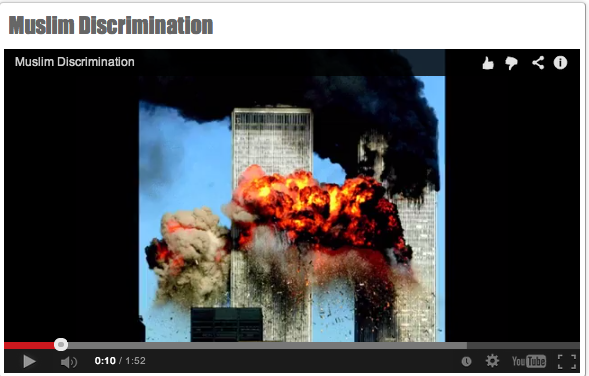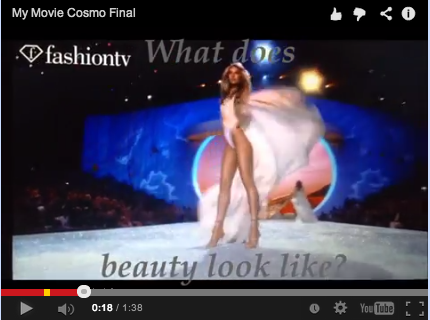(Sean Molloy 3 March 2016)
Overview: Students take the same thesis question they have developed for a text essay and use it to reimagine the essay as a three minute (or less) movie version which they create and publish to some internet platform. For me, the movie project has five steps. We begin with a short written treatment or screenplay. Then, students create and publish a rough cut/first draft movie. Then, students publish final versions that we watch together as a class on “movie night.” Then students also embed or link the final movie version into their website portfolios, together with the text versions of the same essay. Lastly, students add a reflection/meta-analysis essay to their portfolios as well. (I use thesis questions rather than thesis statements, emphasizing inquiry over express argument– but either approach should work.)
Here is a sample assignment. Here is a sample unit schedule, including short lesson plans. Here are examples of student movies, essays and website portfolios. Here are a number of possible assigned readings.
Teaching goals/Theoretical Rationale: My main goal is to explore how multimodal composing processes and rhetorical choices compare to text-centered composing and rhetoric. Liz Clark argues that we face a “digital imperative” to teach new forms of digital writing and publication, including the critical issues raised by them. Working in the “movie” genre opens up exciting possibilities for powerful rhetorical impact, creativity and humor; it provides a excellent comparative lens for meta-analyses of process, genre, and rhetorical appeals. Publication to public platforms raises additional issues involved in composing for and attracting substantial real world audiences, as well as questions of intellectual property and control. A full rationale with sources is here.
Scaffolding: In my course, the movie builds from units on process theory and rhetoric, including classical rhetoric and visual rhetoric. “Rhetorical Readings of Super Bowl Ads or Student Movies” can prepare students to become visual rhetors. “Rhetorical Roller Coasters” can reinforce how rhetorical appeals (ethos, logos, and/or pathos) weave together with kairos to create rhetorical intensity. I have also added a (new for Fall 2014) critical issues scaffolding assignments: IP Path to Green Light.
Tips From Past Classroom Uses: Sean (3 March 2016): I’ve assigned these movie essays in six sections of Hunter’s FYW ENGL 120 class, from Spring 2013 to Fall 2014. Watching previous student movies together and analyzing them together really seems to draw students in. (Here are some sample movies.) I start with a low stakes treatment/screenplay and then a low-stakes draft/rough-cut assignment. We workshop the treatments and drafts in groups. The main benefit of calling for published movie drafts may be to get all the students familiar with new tools and any technical hurdles in advance of the higher-stakes final draft deadline, and allowing them time to help each other solve any problems. Most movies that fail to load/play on Youtube have intellectual property problems. (See the related IP assignment to minimize this problem.) I now ask students for permission to share their movies as they submit the links– as I often want to share this work with other teachers. (Here is the form I use.)
In the Fall of 2014, we began to focus more on building real audiences. Some students chose to become public digital scholars and advocates, both by presenting their work and by promoting viewership. This viewership has continued to grow over time. For example, Nicole’s Burkean analysis visual rhetoric research project movie has almost 700 youtube viewers.
Assessment: For an excellent discussion of recent assessment articles focusing on writing assessment in general, see this Q and A prepared by Kristal Haynes, Hunter College Office of Assessment in June 2014. And here is an Assessment Theoretical Rationale for thick description and ecological writing assessment models. As to these assignments:
1) Self-Assessment: Near the end of the semester, I ask classes to break into teams and build self-assessment weights and guidelines for each piece of their website portfolios that they post to shared google docs. Here is an example from Fall 2013. Recognizing that genre and purposes of each assignment vary, they usually set different expectations for each portfolio element.
2) Comments and Grading: In this complex and creative assignment, open-ended expectations feel more appropriate than checklists or rubrics; there is a real opportunity here to learn from students who often exceed/transcend teacher expectations. I offer extra credit for exceptional elements/effects/choices.
3) Assessment Ideas based on specific teaching goals:
— Digital literacy goals can be met by successful completion and publication: count how many students successfully compose and publish their movies.
— Effective learning of rhetorical appeal concepts in this situation can be assessed by analyzing the rhetorical effectiveness/power achieved in the movie essays themselves, or by assessing students’ rhetorical outlines or rhetorical rollercoasters or their meta-analysis writing.
— Digital publication/audience literacy goals could be assessed by counting viewers, comments or “likes” or by reviewing reflective writings about strategies to attract viewers. (But not all students will want to publically share their work or to promote it.)
— Meta-analysis goals can be assessed by analyzing students’ reflective writings as they connect the movie making process and rhetorical choices to “writing about writing” themes and threshhold concepts of writing theory covered within the course.
— Critical literacy goals can be assessed by analyzing reflective writings, including intellectual property analyses.








